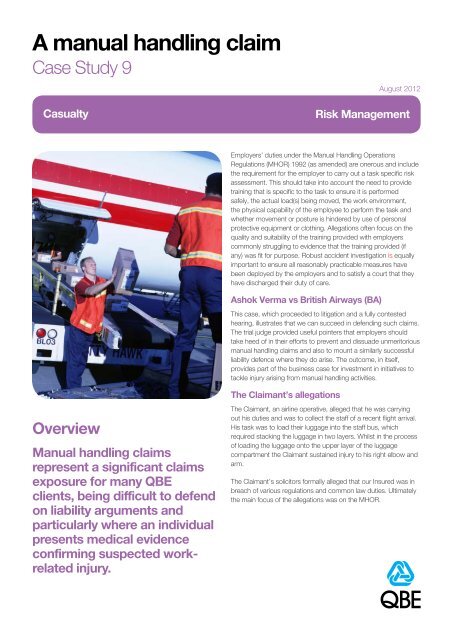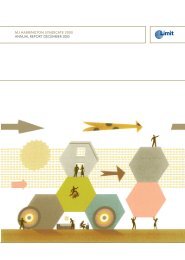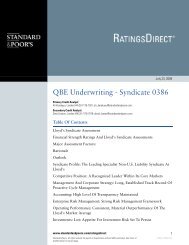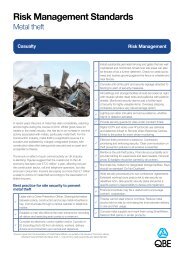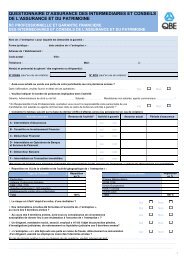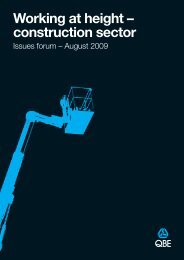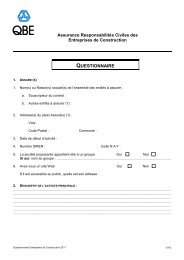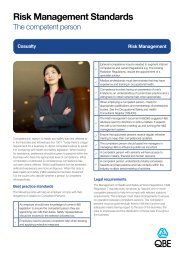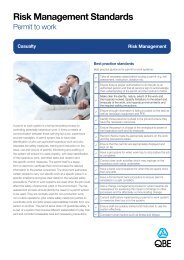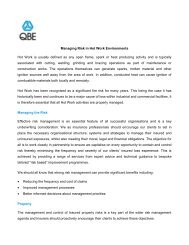Case Study 9 - A manual handling claim - QBE
Case Study 9 - A manual handling claim - QBE
Case Study 9 - A manual handling claim - QBE
Create successful ePaper yourself
Turn your PDF publications into a flip-book with our unique Google optimized e-Paper software.
A <strong>manual</strong> <strong>handling</strong> <strong>claim</strong><strong>Case</strong> <strong>Study</strong> 9CasualtyAugust 2012Risk ManagementEmployers’ duties under the Manual Handling OperationsRegulations (MHOR) 1992 (as amended) are onerous and includethe requirement for the employer to carry out a task specific riskassessment. This should take into account the need to providetraining that is specific to the task to ensure it is performedsafely, the actual load(s) being moved, the work environment,the physical capability of the employee to perform the task andwhether movement or posture is hindered by use of personalprotective equipment or clothing. Allegations often focus on thequality and suitability of the training provided with employerscommonly struggling to evidence that the training provided (ifany) was fit for purpose. Robust accident investigation is equallyimportant to ensure all reasonably practicable measures havebeen deployed by the employers and to satisfy a court that theyhave discharged their duty of care.Ashok Verma vs British Airways (BA)This case, which proceeded to litigation and a fully contestedhearing, illustrates that we can succeed in defending such <strong>claim</strong>s.The trial judge provided useful pointers that employers shouldtake heed of in their efforts to prevent and dissuade unmeritorious<strong>manual</strong> <strong>handling</strong> <strong>claim</strong>s and also to mount a similarly successfulliability defence where they do arise. The outcome, in itself,provides part of the business case for investment in initiatives totackle injury arising from <strong>manual</strong> <strong>handling</strong> activities.OverviewManual <strong>handling</strong> <strong>claim</strong>srepresent a significant <strong>claim</strong>sexposure for many <strong>QBE</strong>clients, being difficult to defendon liability arguments andparticularly where an individualpresents medical evidenceconfirming suspected workrelatedinjury.The Claimant’s allegationsThe Claimant, an airline operative, alleged that he was carryingout his duties and was to collect the staff of a recent flight arrival.His task was to load their luggage into the staff bus, whichrequired stacking the luggage in two layers. Whilst in the processof loading the luggage onto the upper layer of the luggagecompartment the Claimant sustained injury to his right elbow andarm.The Claimant’s solicitors formally alleged that our Insured was inbreach of various regulations and common law duties. Ultimatelythe main focus of the allegations was on the MHOR.
Liability InvestigationOur Insured’s accident investigation confirmed that the Claimantwas loading bags onto the staff bus and, as he tried to placethe second layer of luggage, he twisted his right arm. Theincident was reported but there were no witnesses. The Claimantattended A&E where his arm was placed in a sling and he wasthen sent home.The arrivals procedure at the time involved the driver reversingthe vehicle to the end of the baggage conveyor belt. When thebaggage arrived he was tasked with loading the bags from theconveyor belt into the rear of the vehicle, duly noting the numberof the items. The baggage conveyor was placed at a low levelthereby allowing easy transfer of baggage into the rear of thevehicle. Once the vehicle had been loaded, the driver was thentasked with collecting the flight crew and reconciliation of theirbaggage.The Insured’s safe system of work dictated that all flying staffluggage was limited to a maximum weight of 25kgs. Anythingover 25kgs would be clearly tagged as ‘heavy’ following weighingfrom a conveyor belt before having their luggage accepted ontoany flight. The task being carried out by the Claimant had beenfully risk assessed and he had undergone comprehensive PristineCondition <strong>manual</strong> <strong>handling</strong> training only one month before theindex accident. Witness evidence confirmed that the ‘secondlayer’ of baggage to which the Claimant was trying to add thebag would not have been more than 2 to 2½ feet in height.Our defence of this <strong>claim</strong> effectively centred around the fact thatthe Claimant had been fully trained in the correct <strong>manual</strong> <strong>handling</strong>techniques in accordance with the safe working procedureand that his non-adherence to his training was the cause of hisaccident.Flying staff baggage was restricted to weigh below 25kgs andthere is no evidence to suggest that the bag involved in the indexaccident was heavier than this.2
Trial outcomeIn summing up at the hearing, the trial Judge made it clearthat the key evidence was that of the training provider,whose representative gave important evidence upon theManual Handling training that the Claimant had received i.e.demonstrating:-• Why the Claimant’s demonstrated movement under crossexaminationmeant that extra unnecessary pressure wasbeing placed upon his body• That this was exactly the type of movement that washighlighted as being a risk in their training programme• How the Claimant ‘should’ have lifted the bag, and further,that the Claimant would have been trained to lift from theground, up to a variety of heights.In giving his judgment the Judge stated that he found the defencewitnesses to be more credible than the Claimant. He acceptedour Insured’s evidence that the bag in question was not likelyto have weighed in excess of 25kgs and, had it weighed more,would have had a ‘heavy’ tag attached to it. He also acceptedevidence that the conveyor belt was not a necessity for theoperation and that it was entirely normal for bags to have tobe lifted from the tarmac. The Judge went on to state that ourInsured, in sub-contracting Pristine Condition, had satisfied allrelevant parts of the Manual Handling Regulations by takingaccount of every risk that the Claimant could have faced in histask. He stated that it was evident that the Claimant had notfollowed his training and that he was therefore the author of hisown misfortune.Learning PointsThe detailed and task specific training provided in this case waskey in demonstrating that BA had given full consideration topreventing the type of injury which the Claimant sustained. It wasalso important to have a witness from Pristine Condition who wasable to give the judge a visual demonstration of the correct liftingtechniques. In summary:-• It is important to demonstrate that an effective system of workis in place. On this occasion a system for regulating heavybaggage was evidenced• Generic risk assessments may not be enough to persuadea judge that proper consideration has been given to thepotential risk of injury. In this case a task-specific riskassessment coupled with evidence of how the training wasdelivered to the Claimant was far more useful• Witness evidence from the trainer, or someone who deliversthe course, is vital to provide evidence of the training contentand when arguing its adequacy• It is important, as in this case, to produce the register signedby the Claimant to confirm his attendance at the training.Often employers rely on electronic documents simplyconfirming that individuals were ‘enrolled’ on a course suchthat actual attendance can be challenged. Employers alsooften struggle to provide evidence of the training content.Impact<strong>QBE</strong>’s reserve on this case was £48,000 inclusive of costs. Therelease of this reserve represented a significant financial savingfor <strong>QBE</strong> and BA. Equally the case sets a precedent, preventingsimilar <strong>claim</strong>s and rewarding the significant efforts made indeveloping appropriate systems of work and training that wereultimately recognised by the court.Conclusion and <strong>QBE</strong> commentThis case highlights the need for the deployment of acomprehensive, task specific <strong>manual</strong> <strong>handling</strong> trainingprogramme that is ‘fit for purpose’ when seeking to defend civil<strong>claim</strong>s pled under the MHOR. The Courts place great weight andemphasis on evidence of appropriate training of employees intask specific <strong>manual</strong> <strong>handling</strong> lifting techniques. Many employersstill fail in this area. However, where evidence of effective trainingcan be provided by the employer, backed by documented safesystem of work and appropriate risk assessment, the Claimantwill invariably have a significant mountain to climb in dischargingthe burden of proof upon them to satisfy any presiding court thattheir employer is at fault.<strong>QBE</strong> European OperationsPlantation Place30 Fenchurch StreetLondonEC3M 3BDtel +44 (0)20 7105 4000fax +44 (0)20 7105 4019enquiries@uk.qbe.comwww.<strong>QBE</strong>europe.comDis<strong>claim</strong>erThis publication has been produced by <strong>QBE</strong> Insurance (Europe) Ltd (“QIEL”). QIEL is a company member of the <strong>QBE</strong>Insurance Group. Readership of this publication does not create an insurer-client, or other business or legal relationship.This publication provides information about the law to help you to understand and manage risk within your organisation. For fulldetails of the dis<strong>claim</strong>er surrounding this publication please visit http://www.qbeeurope.com/legal/publication-dis<strong>claim</strong>er.asp3705/<strong>QBE</strong>ManualHandlingClaim<strong>Case</strong><strong>Study</strong>9/August2012<strong>QBE</strong> European Operations is a trading name of <strong>QBE</strong> Insurance (Europe) Limited and <strong>QBE</strong> Underwriting Limited, both of which are authorisedby the Prudential Regulation Authority and regulated by the Financial Conduct Authority and the Prudential Regulation Authority.


